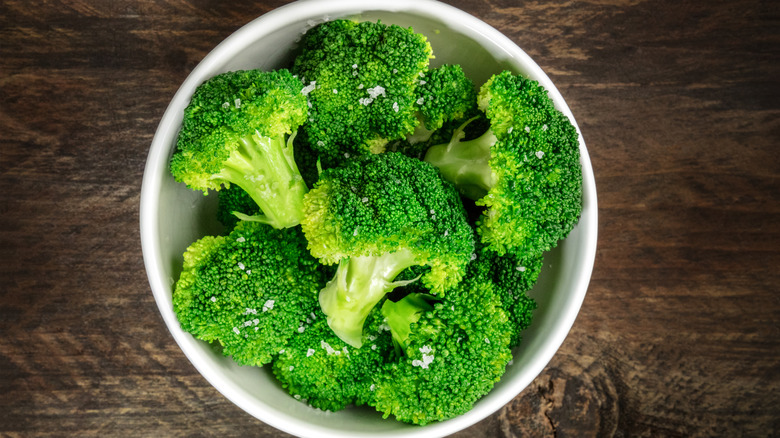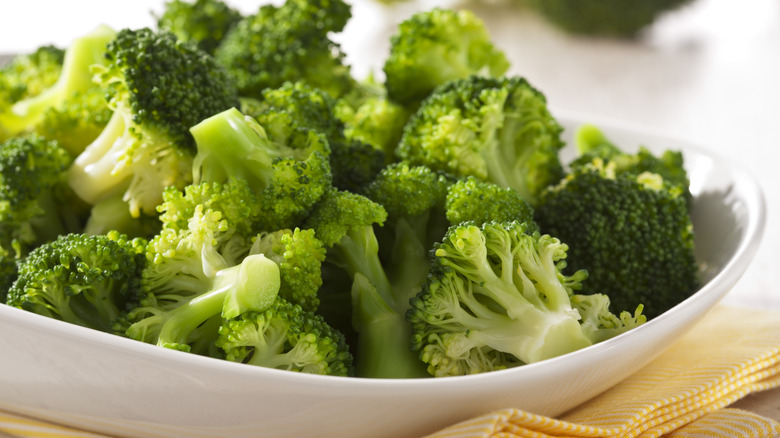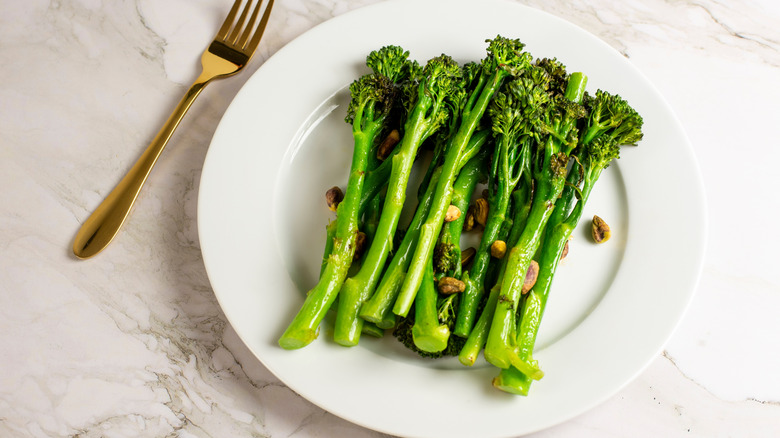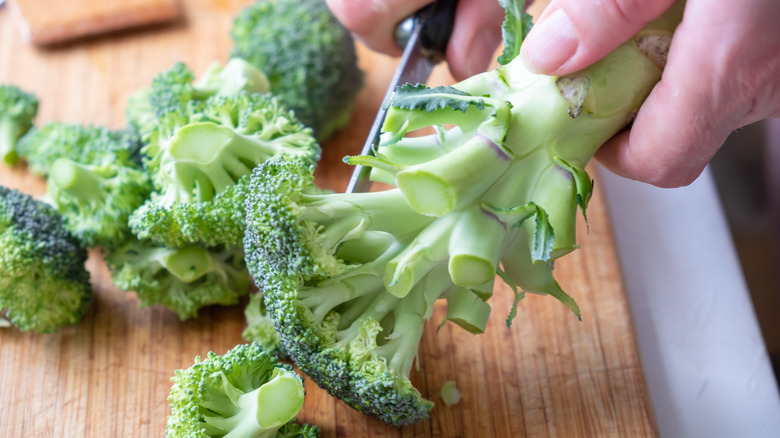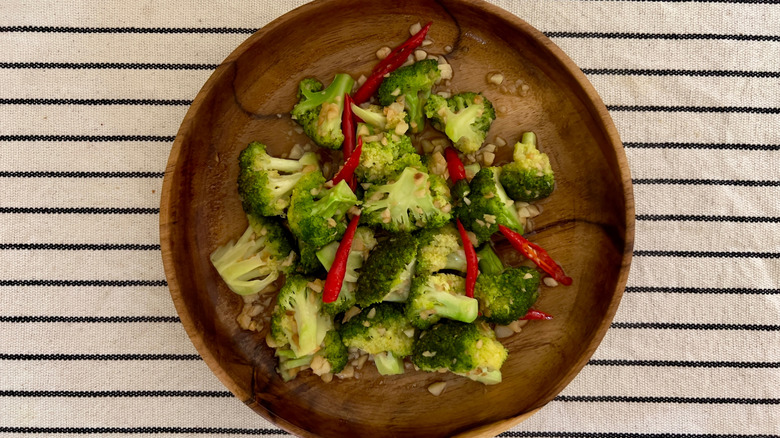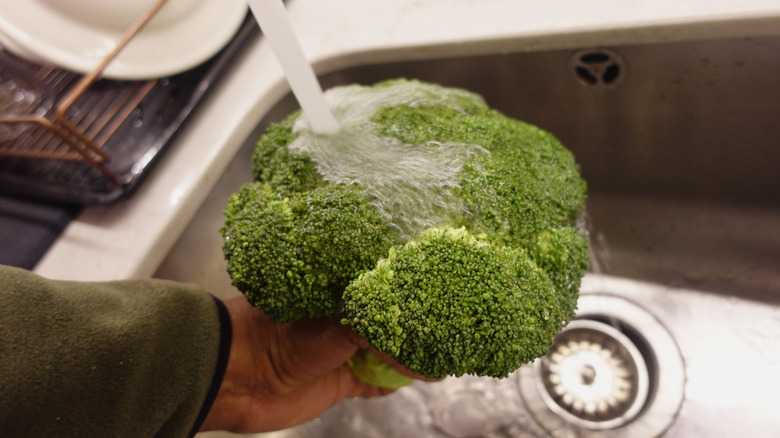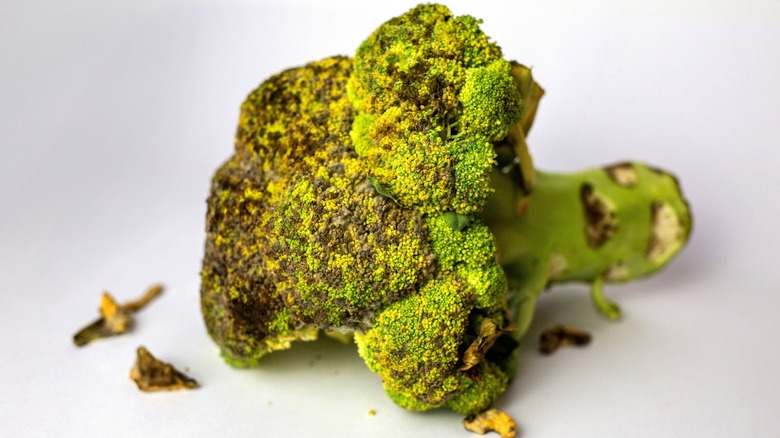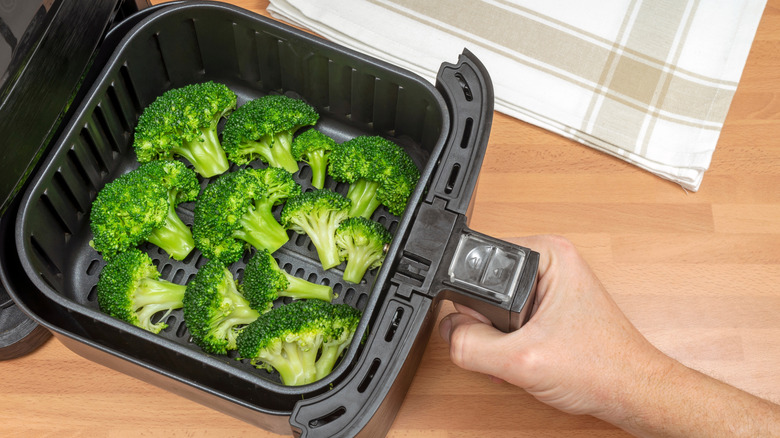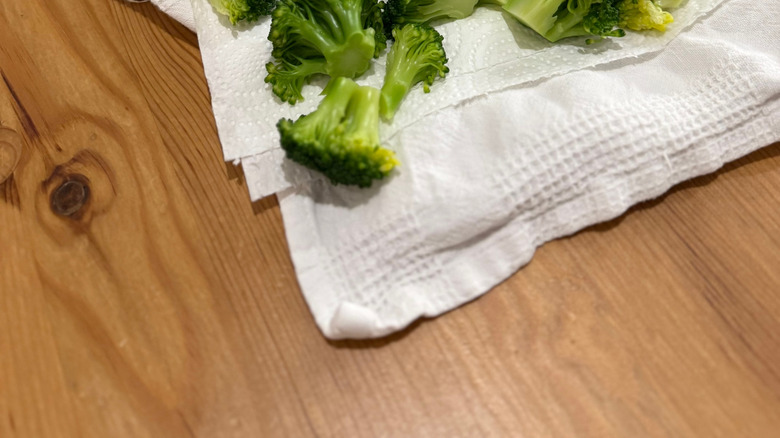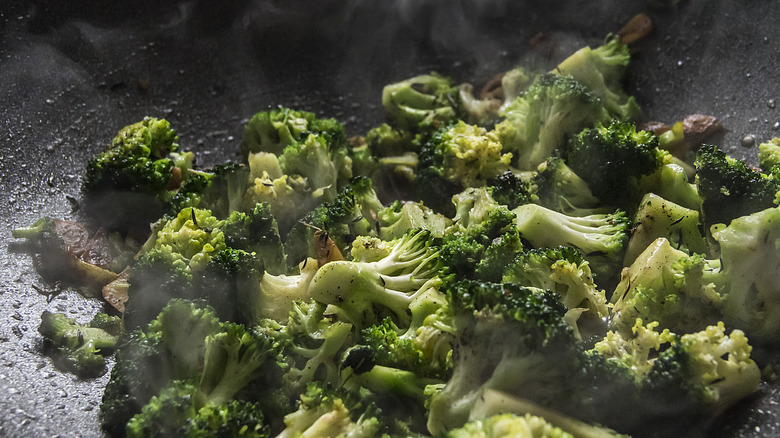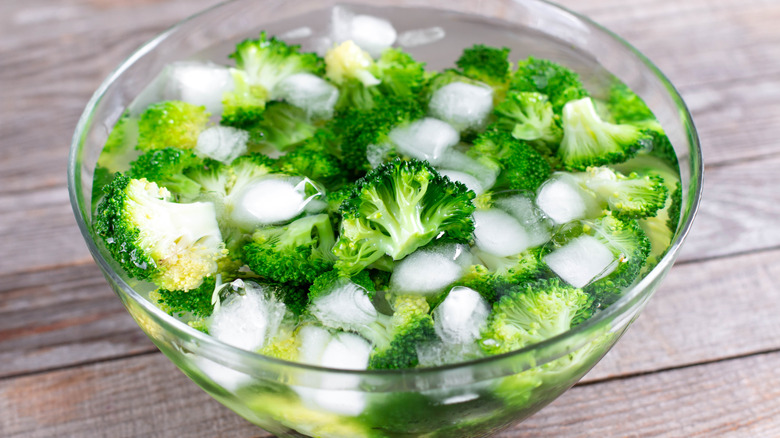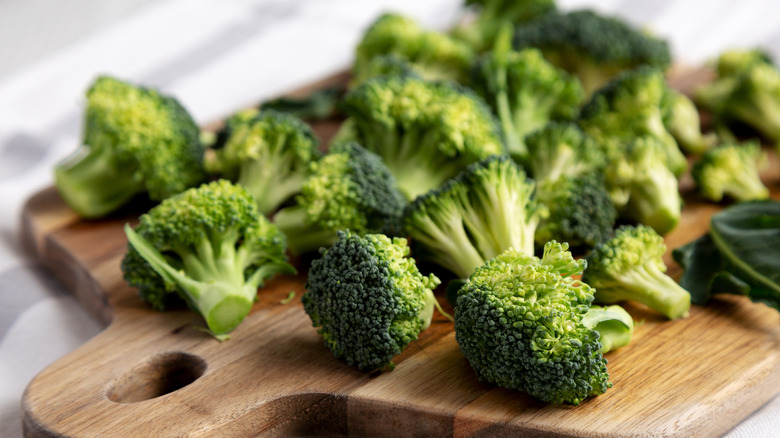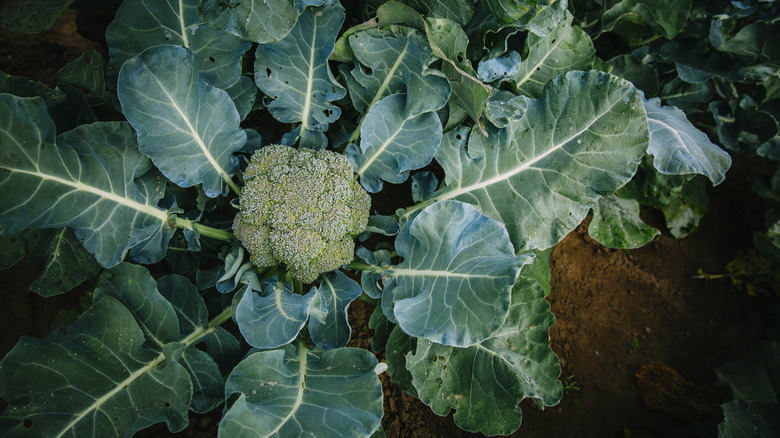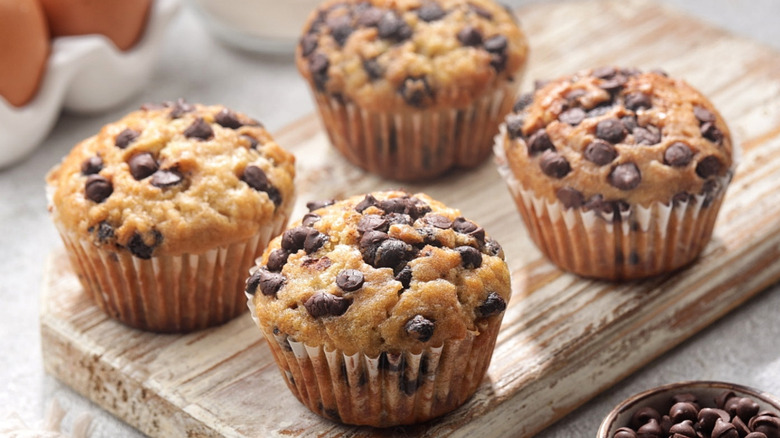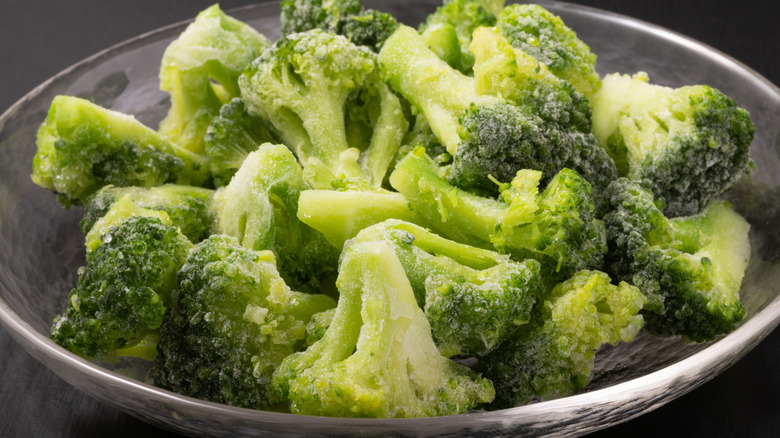14 Mistakes Everyone Makes When Cooking Broccoli
How hard can it be to cook broccoli? As it turns out, it's surprisingly tough. This vegetable is one of the most popular out there, and there are dozens (if not hundreds) of delicious broccoli recipes that suit pretty much every palette. However, anyone who's ever cooked broccoli for slightly too long, or opted to use florets that just aren't fresh enough, will know how disastrous things can be when stuff goes wrong. Broccoli can go from crisp and subtle-tasting to soggy and sulphuric in an instant, and getting it wrong won't just ruin your meal — it'll also stink out your house.
Plus, for such a simple and widely available ingredient, there are lots of different ways to cook broccoli that people forget about. With that comes a load of different mistakes that you can fall victim to. That's if you get your broccoli selection right to begin with, too: There are a lot of different varieties of this vegetable, and each of them has slightly different rules about how you cook it. We decided that we couldn't sit by any longer and watch people make the same old mistakes every time with their broccoli, and so we're putting things straight once and for all.
1. Mistake: Overcooking your broccoli
Look, folks, we're gonna put our hands up and say it: All of us have overcooked broccoli at one time or another, and most of us are aware of how easy it is to do. When it's raw, broccoli is firm and crunchy, but it absorbs moisture surprisingly quickly — and it has a very definite tipping point where things turn from good to bad. Unfortunately, that tipping point can sneak up on you when you're boiling or steaming broccoli. In the blink of an eye, it can become waterlogged and pulpy, with an eggy smell and an unpleasant flavor.
The key with broccoli is to go by color and texture. When boiling broccoli, look for a bright green color and a crisp texture, which yields to a fork but still has a bit of resistance and bite to it. Generally speaking, boiling florets to this point will take about 2 to 3 minutes. Steaming broccoli can take slightly longer, but you should make sure you're checking it every few minutes to avoid it breaking down too much. Keep an eye on your broccoli when you're roasting or frying it, too, as it can very quickly burn and turn brittle and acrid.
2. Mistake: Treating different types of broccoli the same
There are lots of different types of broccoli out there, folks — and much like children, you kinda need to be responsive to their individual needs. As well as your regular broccoli, you've also got broccolini, broccoli rabe, Chinese broccoli, purple sprouting broccoli, and many others. These broccoli types will vary in taste slightly, but they're also different shapes and thicknesses, so you'll need to adjust your cooking times (and occasionally your flavors) accordingly.
The good news is that none of them need particularly fancy or unexpected cooking methods: You'll just need to slightly tweak how you do things. For example, you can cook broccolini in the same way as broccoli, but it will generally take less time than the regular vegetable due to its thinner dimensions. These dimensions also mean that you can use them slightly more easily in certain dishes, like in pastas or stir-fries. Purple sprouting broccoli can also be cooked in the same way as the standard version, but you might want to think about ways of cooking it that'll honor its vibrant color, like pan-frying and steaming instead of boiling.
3. Mistake: Throwing away the stalks
We're hereby announcing a ban on throwing away broccoli stalks. It's something that everyone does — after all, they hardly look as good as the florets — but when you do so, you're throwing away so much potential. Broccoli stalks are perfectly safe to eat and are as tasty as the florets, and they have the added benefit of being way more versatile and easy to handle. Because of their blocky dimensions, you can trim them into pretty much any shape you like.
This ability to sculpt your broccoli stalks means that you can add them into loads of different dishes. We particularly love using them in stir-fries by cutting them into strips that match the shape of your peppers and onions. You can also use them to bulk out a curry or a stew, where they'll add a tender bite and a nice, nutty flavor. It's also easy to forget that broccoli stalks can be eaten raw, and they have a delightful crunchiness that makes them excellent in salads. Broccoli stalks are especially good in copycat artichoke salads, or you can make a coleslaw out of them.
4. Mistake: Only boiling your broccoli
By only boiling your broccoli and not trying out any other cooking styles, you're missing out on a lot of fun. Don't get us wrong: Broccoli is great when it's boiled, and it's a vegetable that stands up surprisingly well to the cooking style (when you don't overcook it, of course). However, it's far from the most exciting thing you can do with it, and it can lead to the broccoli having a fairly flat, one-note flavor. As well as this, boiling broccoli can make it slightly less nutritious than cooking it in other ways, as the boiling process causes a higher reduction in vitamin C than other methods like microwaving or steaming.
If you're opting to eat your broccoli simply, steaming is our preferred option, as it leads to a slightly more tender bite. However, don't underestimate the power of putting some color on your broccoli for pure flavor. Oven-roasted broccoli is simple and delicious, and gives you a tender vegetable that has a delightful brown exterior that's bursting with taste. Sautéeing broccoli with other vegetables is also a speedy way to make a quick side dish and marry it with other flavors.
5. Mistake: Not cleaning your broccoli before cooking it
Cleaning broccoli seems like an unnecessary extra step for a lot of people, and we get it. After all, if you're boiling it, then what's the point in adding more water beforehand? Well, even if you're plunging your broccoli in a boiling pot, you should always be cleaning it. Cleaning broccoli removes any impurities from the vegetable, allowing you to have as clean a result as possible. Crucially, it also gets rid of any patches of soil or dirt that might remain on its surface, which can cling on even when you're boiling it. As well as this, it can get rid of any pesticides still present on the vegetable.
The good news is that cleaning broccoli is super simple. The easiest way, of course, is just by running it under a tap for a few minutes, rustling it up slightly while doing so to let the water get into every corner. If your broccoli is especially dense, it can also be a good idea to soak it for a few minutes to allow the water to get between the florets. If you're cleaning your broccoli, just make sure that you're doing so just before cooking, as washing it and then popping it back in the fridge can limit its lifespan.
6. Mistake: Starting with broccoli that's past its prime
We all want our broccoli to be crisp, juicy, and fresh-tasting. Well, unfortunately, that just won't happen if you're using broccoli that's past its prime. Too many of us buy a head of broccoli and then pop it in our crisper, to use days later. Then, we pull it out, and it's suddenly bendy or a little mushy — and we pop it in to cook, hoping that it'll somehow revive. Well, it won't. Using old broccoli to cook with can leave you with a mushy, flaccid result that has none of the fresh flavor that you wanted in the first place.
So, before you start cooking, check your broccoli carefully. Fresh broccoli should have a uniform green color, a good firmness to it, and no noticeable odor. It should be free of any soft patches or bruises, and shouldn't be overly bendy. If your broccoli feels a little old but still in reasonable condition, it won't be unsafe to eat, but it probably won't taste good. Luckily, you can help yourself out by storing your broccoli so that it stays fresh for longer. Try to avoid tucking it away in a part of your fridge that has no air circulation, and keep it at a reasonable temperature.
7. Mistake: Crowding your broccoli
Nobody likes to be crowded, right? Well, neither does broccoli. Like most vegetables, broccoli doesn't do well if it's packed too tightly into a pan or onto an oven sheet, and it needs some space to breathe. This is particularly an issue if you're roasting it: If you line your oven tray up with broccoli and leave no space between them, it'll never develop a proper brown color, and the moisture that collects around it while cooking won't have anywhere to flee to. Instead, it'll steam, turning mushy and flavorless. The same issue can occur when you're air-frying broccoli.
So, when you're cooking your veggies using either method, make sure there's a good amount of space around each piece. You should do this when you're boiling or steaming it, too. When boiling broccoli, you need to make sure that the water can circulate around it properly, or else it'll develop a mushy and fairly inconsistent texture. This is the case when it comes to steaming as well, as the hot, moist air needs to be able to circulate around and envelop each piece. Try not to pack it too tightly in your steaming basket.
8. Mistake: Forgetting to dry your broccoli before frying or roasting it
So, you've done what all the cooking blogs tell you, and washed your broccoli thoroughly. You've chopped it up, filled your baking sheet perfectly with each piece, and popped it in the oven. Then, you take it out, and ... It's soft. Pulpy. A pallid green with no caramelization whatsoever. What happened?
Well, you forgot to dry it. It's important to remember that any moisture that's left on broccoli when you fry or roast it will have to evaporate, and a lot of the time it doesn't just magically disappear from the vegetable's surface. Instead, the evaporation process will start to steam the broccoli, leaving it soft and unpleasant. This is a particular problem with broccoli because of its florets, which are densely packed, meaning that any moisture tends to lodge in them.
The solution is to make sure that they're super dry before you do anything with them. The best way to do this is with a paper towel. Pat your broccoli thoroughly after washing it, making sure to really press the towel onto its surface. The paper towel will suck up most of the moisture present, and then you can leave it to air dry until you're ready to go.
9. Mistake: Moving your broccoli around too much as it cooks
When it comes to broccoli, it's important to learn the art of patience — especially when you're cooking it in the oven or frying it. The more you move around your broccoli while cooking, the less it will brown. Browning produces flavor on food via the Maillard reaction, which is essentially caused by different components in the food reacting to heat and developing that caramelized exterior and deep taste. When broccoli undergoes the Maillard reaction, it develops an intense nuttiness that really brings the vegetable to life.
The problem is that when you're frying broccoli, the Maillard reaction requires contact between the pan and the food itself. When you move it around too much, you're limiting the exposure of the food to the hot metal, and therefore the flavor it unlocks. When you're baking or roasting broccoli, moving it about too much can also disrupt the connection between your baking sheet and your broccoli. The solution is just to leave it where it is, gang. If you're roasting only flip once, and if you're frying try not to stir it endlessly. Your tastebuds will thank you.
10. Mistake: Forgetting to use an ice bath
Boiling broccoli can be surprisingly difficult to get just right — and the reason for that is what happens after you're done. When you boil broccoli and take it out of the water, it remains scorchingly hot and enveloped in steam. This heat and scalding moisture continues to cook the broccoli, meaning that even if you pull it out at just the right time, it can quickly turn from vibrant green to a dullish, slightly gray color. Its texture can also continue to transform, with the broccoli getting softer and mushier as time goes on.
The solution is an ice bath, folks. An ice bath can stop cooking in its tracks, which is especially important when it comes to broccoli and other vegetables. When you plunge your broccoli into an ice bath after blanching it, it retains its intense green color and crunchy, snappy texture. You can then serve them straight away (they might be slightly colder, but if you're just giving them a quick dip then they'll retain some heat), or continue to cook them. By blanching your broccoli, soaking it in an ice bath, and then roasting it, you can give it a meltingly soft interior and a gorgeously brown outside.
11. Mistake: Not banging your broccoli
If you haven't banged your broccoli recently, you're not doing things right. This countertop hack can help you separate your broccoli florets instantly, instead of having to rip them apart one by one. All you do is pop your broccoli in a Ziploc bag floret-first, with the stem sticking out of the opening. You then just have to smack your broccoli on a sturdy table a couple of times, until the vegetable breaks apart, leaving your florets separated into bite-sized pieces. By putting the broccoli in a bag, you avoid your florets flying all over your kitchen. Instead, they remain contained.
When you're banging your broccoli, you need to keep a few things in mind. The first is that you'll need to do this on a sturdy table or countertop: If you do it on a flimsy surface, you may either cause damage or destabilize things. You should also watch how hard you're banging the vegetable. Whacking it too hard may bruise it, leaving your broccoli inedible.
12. Mistake: Forgetting to use your broccoli leaves
You know those large leaves that come attached to your broccoli? How many times have you used them instead of throwing them away? If you're anything like most people, you've probably never used them at all, and have always considered them to be a nuisance. However, when you throw them away, you're not only throwing away a lot of nutrition — you're throwing away a delicious addition to your food.
Broccoli leaves look as though they're bitter and tough, but they're actually fairly sweet and tender compared to other leafy greens like kale. This makes them a great addition to salads or power bowls where you want a pop of greenery without too much chew. They're also awesome when added to a smoothie or green juice, as their slightly less fibrous nature means that they break down more easily and won't get stuck in your teeth. If you want to keep things simple, you can just steam them alongside your broccoli florets.
13. Mistake: Not using broccoli in your desserts
Broccoli in dessert? Yes, folks, it's a thing — and a good one at that. Although a lot of people balk at putting broccoli in their desserts, doing so can offer you benefits in more ways than one. Naturally, mixing broccoli into desserts improves their nutrition, adding some vital vitamins, minerals, and fiber to dishes that are normally pretty unhealthy. Additionally, mixing broccoli into desserts can give them a slightly nutty, earthy undertone that doesn't overwhelm but instead adds a little extra flavor to the dish.
If you're adding broccoli to your dessert, you sometimes don't even need to cook it. For chocolate broccoli muffins, for example, you just need to grate your broccoli raw and then mix it with your muffin batter. Some recipes, however, may specify that you need to cook your broccoli, as this will give it a softer texture. If you're new to making desserts with broccoli, it's always best to follow recipes in the first instance. The last thing you want is to end up with a dessert that tastes solely of the vegetable.
14. Mistake: Cooking your frozen broccoli incorrectly
Frozen broccoli is a home cook's best friend. Yet, so few people know how to treat it right. This form of broccoli is especially prone to becoming mushy and tasteless, and this has led a lot of folks to just avoid using it entirely, out of fear of ending up with terrible veggies. However, when you nail your cooking and flavoring technique for frozen broccoli, you can ensure that you have a tasty side dish without having to buy frozen produce every time you want some.
Frozen broccoli is perhaps most tasty when it's roasted, but there's one key oil mistake that people make which ruins it. Adding oil to your broccoli before you pop it in the oven will prevent the water on its surface from evaporating properly, leaving things pretty soggy. Instead, you'll want to add the oil once it's already been in the oven for a while. Remember, too, that frozen broccoli can sometimes taste a little more flat than the fresh kind, and lack its bright, slightly citrusy flavor. To bring this back, you need to break out the lemons, hitting it with a little juice (and maybe some zest) to make things more sprightly.
